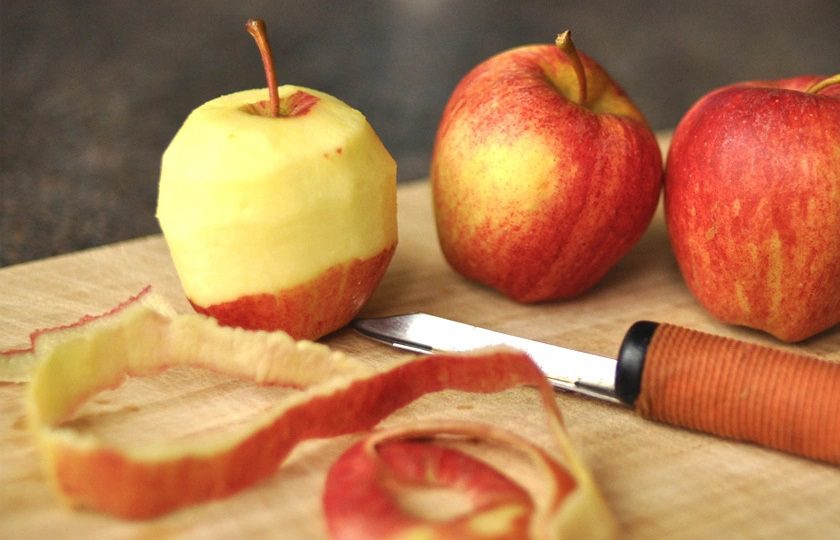Don’t get rid of the skin of the fruit: apple peel is packed with nutrients your body needs
Apples are among the most consumed fruits in the Western world, although some people don’t like the skin. Apple skin or peels are often discarded due to habit or preference by eaters, while others are worried about consuming potential pesticide residue or the natural wax coating that appears powdery on the peel.

They’re certainly missing a ton of nutrients. A raw apple with skin contains up to 332 percent more vitamin K, 142 percent more vitamin A, 115 percent more vitamin C, 20 percent more calcium and up to 19 percent more potassium than a peeled apple.
According to the United States Department of Agriculture (USDA) National Nutrient Database, one large red apple with its skin intact (unpeeled) contains about five grams of fiber, 13 milligrams of calcium, 239 milligrams of potassium and 10 milligrams of vitamin C – just to name a few important nutrients. By peeling apples and not eating the skin, you miss out on powerful nutritional pluses. You’re discarding the most nutrient-rich part of the fruit.
The skin or peel of fruits and vegetables is generally higher in antioxidants, fiber, vitamins and minerals than the flesh component. And antioxidant levels in the skins of fruits could be up to 328 times higher than those found in the flesh. So, to get the greatest amounts of benefits, eat the skin of the apple.
Apples produce a natural wax coating that is safe to eat, but remnants of pesticides may be trapped underneath them if they’re not organically grown. So wash the apples properly to remove any contaminants from the peel.
Do not wash apples in soap because detergents can be absorbed into the peel. You also shouldn’t wash apples in a sink or bowl of water because contaminants (if any) can spread through the water. You will be able to remove most of the wax and any residue by rinsing the apple under cool water and drying them with clean towel or paper towels. If needed, rub the apple skin gently with a soft cloth or vegetable brush to scrub away the wax.
What is so special about apple peels?
Apples are one of the fruits dietitians recommend not peeling. A study published in the Journal of Agricultural and Food Chemistry compared the values of the peels to those of the flesh and flesh plus peel components of the apples in terms of the phytochemical content, antioxidant activity and antiproliferative activity of several varieties of apples that are commonly used in applesauce production in New York state.
The study found that the peels of apples are high in phenolics. Apple peels were also shown to more effectively inhibit the human liver cancer cells from HepG2 cell line, than the other apple components. The peels showed the most bioactivity, inhibiting cell proliferation by 50 percent at the low concentration. The apple peel stores natural compounds called triterpenoids, which either kill or slow the growth of cancer cells.
Apple peel, as a contributor to the entire quantity of the examined concentration of bioactive compounds, was found to have great amounts of flavonols – including quercetin and anthocyanins, which have been shown to exhibit anti-inflammatory, anti-thrombogenic, anti-diabetic, anti-cancer and neuroprotective activities. It also contains ascorbate, total phenolics and thiols (cysteine and glutathione).
According to experts, every apple peel carries 8.4 milligrams of vitamin C and 98 IU of vitamin A. The peel also contains about 72 percent of the apple’s antioxidant vitamin E and bone-building vitamin K. The skin also holds nearly half the total iron and the apple’s folate – important in red blood cell formation and for healthy cell growth and function. These nutrients are also crucial during early pregnancy to reduce the risk of birth defects in the brain and spine.
The peels have significantly higher total antioxidant activities (neutralizing unstable molecules called free radicals) than the flesh plus peel and the flesh. Within each variety, the total phenolic and flavonoid contents were highest in the peels, followed by the flesh plus peel and the flesh. The peel contains about 27.5 percent of the flavonoids found in a whole apple.
Amazing health benefits of apple skin

Studies found that apple skin does the following:
– Support a healthy immune system
Apple peel has vitamin C, which strengthens the immune system, helps defend the body from infections and diseases and heals wounds.
– Protect against cancer
Flavonoids in apple peels may inhibit the growth of cancer cells, according to the Linus Pauling Institute. A study published in Nutrition and Cancer showed the strong antiproliferative effects of apple peel extract (APE) against cancer cells.
According to a study conducted at Cornell University, apple peels are rich in triterpenoids, which are compounds that help protect your body against certain types of cancer, such as liver, colon and breast cancer, and antioxidants that can lower the risk of lung cancer.
– Support brain health
Apple peels contain quercetin, a flavonoid and powerful antioxidant that protects brain cells from degeneration in rats and in humans. This was later confirmed in a study published in Biomolecules in 2020 that reported on the neuroprotective effects of quercetin in Alzheimer’s disease (AD), which contributes to 60-80 percent of total dementia cases – mostly affecting elder people (65 years of age or older). Quercetin in apple peels protects neural cells by reducing oxidative stress from free radicals and neuroinflammation.
– Support heart health
Apple peels are high in potassium, a mineral that helps control blood pressure and can help reduce the risk of stroke. According to the USDA, a large red apple with its skin intact contains about 5 grams of fiber, 13 milligrams of calcium, 239 milligrams of potassium and 10 milligrams of vitamin C.
A study published in Nutrients provided supporting evidence that apple peel contains a significantly higher content of phenolics and fiber (soluble and insoluble) – used in medicine for high cholesterol, high triglycerides, heartburn and many other conditions. The peel from a medium apple contains 1.3 grams of total fiber.
Pectin, a soluble fiber in apple peels, has a major role in lowering cholesterol by suppressing cholesterol absorption and uptake, as well as providing beneficial effects on glucose metabolism. Preventing cholesterol from building up in the lining of blood vessels helps prevent atherosclerosis and heart disease.
– Support a healthy digestive system
Apple skin also contains insoluble fiber, which is the type of fiber that doesn’t absorb water. It provides bulk in the intestinal tract and helps food move more quickly through the digestive system.
A study published in PLoS ONE in 2013 provided evidence of the capacity of dried apple peel polyphenols (DAPP) to reduce oxidative stress and inflammation – two pivotal processes involved in inflammatory bowel diseases.
– Support healthy glowing skin
According to a study published in Chemical Central Journal, the peel of an apple is rich in vitamins and minerals, including polyphenols that help protect against ultraviolet (UV) radiation and lead to younger-looking skin. Apple peels are also rich in vitamin C, which prevents premature aging and enhances skin glow.
– Support eye health
Doctors suggest the intake of high vitamin A for treating eyesight problems. Apple peals offer an adequate source of vitamin A to protect your vision and develop healthy linings in your eyes and other organs and in important processes, such as cell division
– Promote sensible weight management goals
Apple peel is a rich source of dietary fiber that can help you feel fuller for longer periods. When combined with regular exercise and a balanced, healthy diet, eating apples with their skin can support reasonable weight management goals.
According to a study conducted by the University of Illinois, which was published in the journal PLoS ONE, apple peels contain ursolic acid that helps burn calories and may also help protect against obesity.
With apple peel, the amount of brown fat or brown adipose tissue (a special type of body fat that is turned on when you get cold) can increase in the body, causing it to burn more calories, leading to reduced weight.
yogaesoteric
September 15, 2022
Also available in:
 Français
Français
